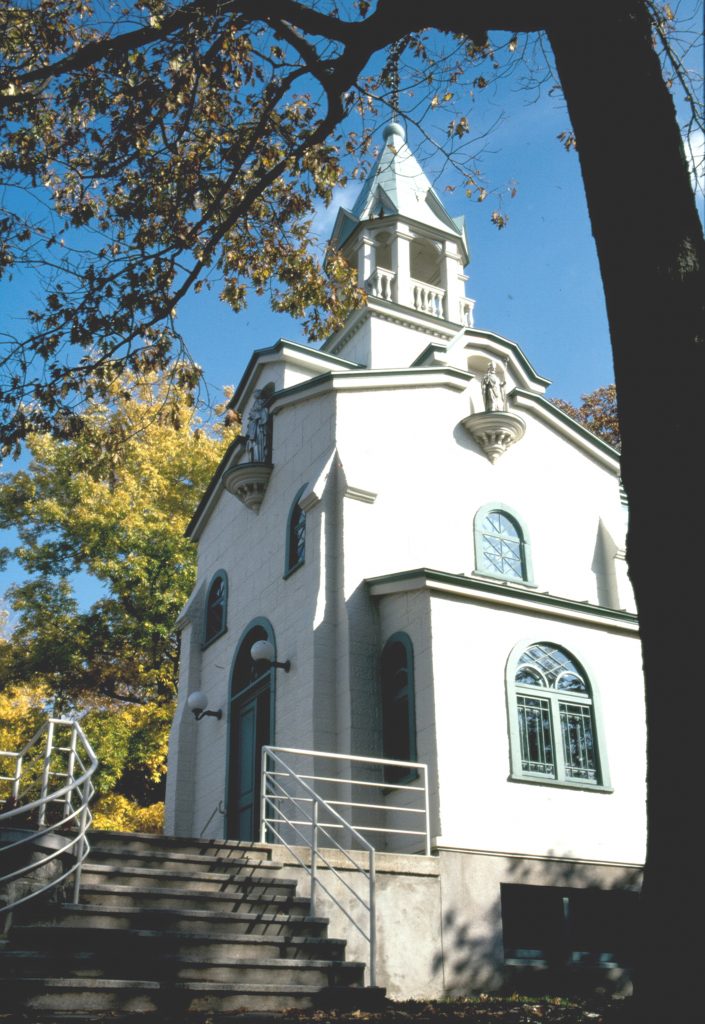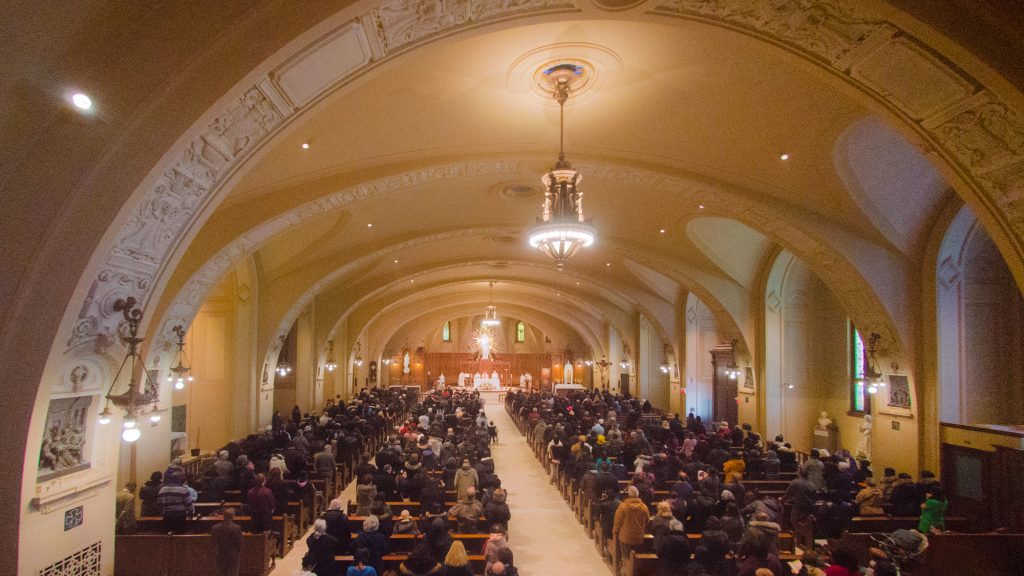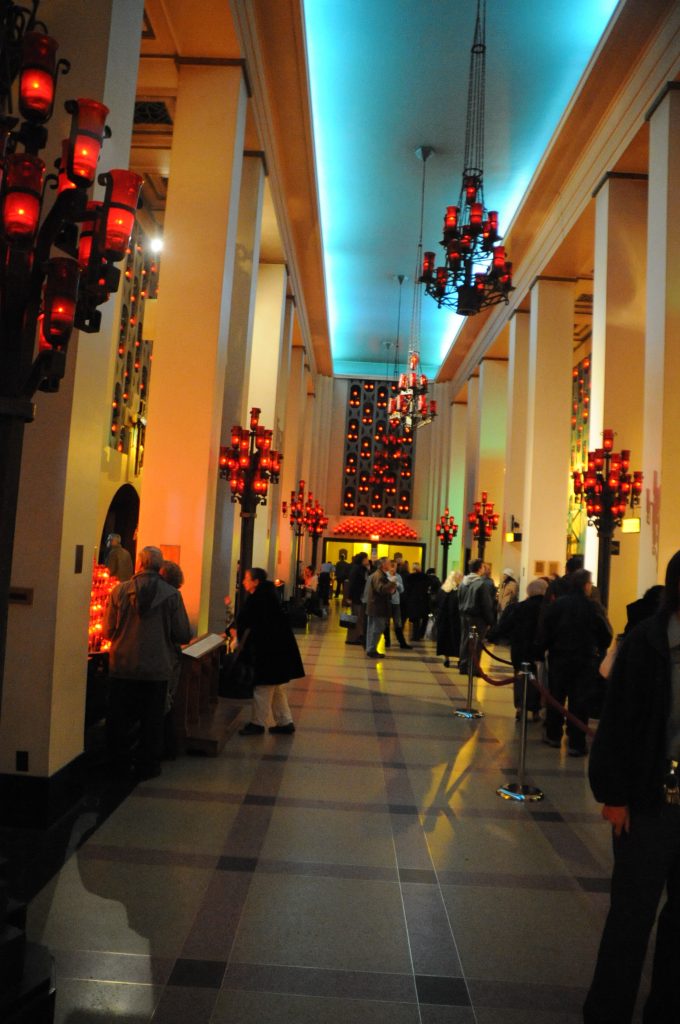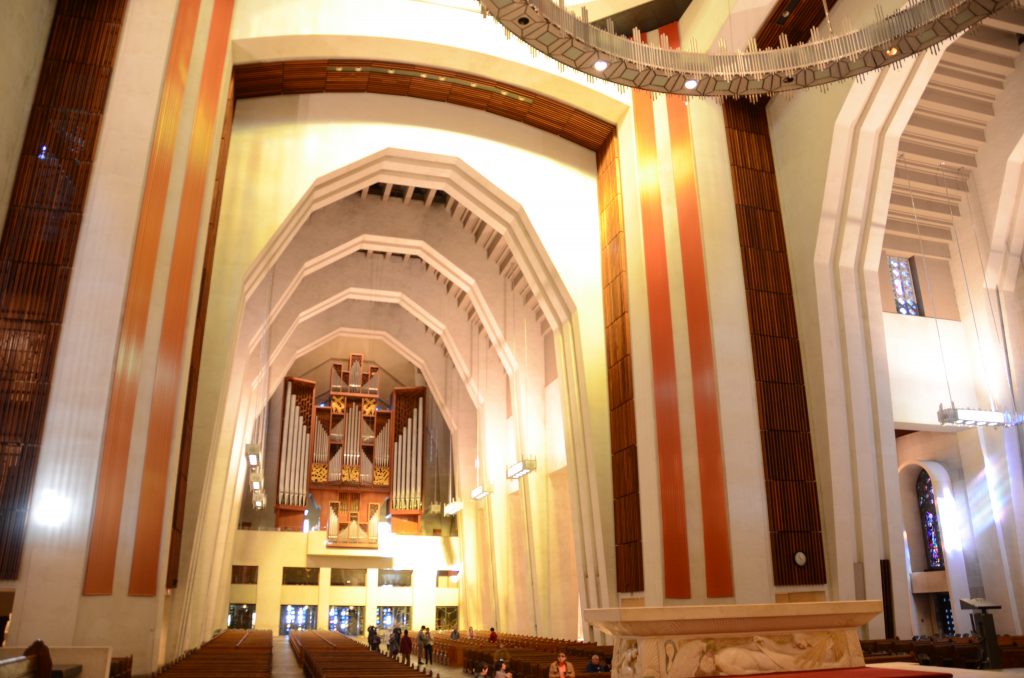Something worthy of note about Saint Joseph’s Oratory of Mount Royal is the diversity of the architectural styles in its places of worship. The first primitive wooden chapel dates from 1904. The planning for the Basilica with a crypt church dates back to 1914 but was not finally finished until the end of the 60s.
Thus, across the decades and thanks to the talent of several generations of architects, artists and artisans this monumental ensemble was realized.
Come onto the grounds of Saint Joseph’s Oratory and you will enter into its architectural universe, composing an artistic heritage and illustrating a happy concurrence of influences and styles.
The Original Chapel
The first chapel was put up in 1904 by Brother Abundius, CSC (a confrère of Brother André) with the help of some lay friends. It was a diminutive structure to be sure — 4.5 meters by 5.5 meters (15 feet by 18 feet). And so, it was aptly called an “oratory”, which is usually considered to be a small wayside shrine.
| July 1904: Construction begins |
| October 19, 1904: Blessing and First Mass |
- The Chapel was built with spruce flooring and pressed metal ceiling and roof.
- It was enlarged four times: in 1908 (August and November), 1910, and 1912.
- The altar was carved by Brother Abundius during the winter of 1906.
- Damaged by fire in February 1951, the chapel was restored according to the original plans.
- The room where Brother André lived after being appointed caretaker of the Oratory is found above the chapel. This room has remained substantially the way he left it.
- The chapel was moved twice; first in January 1918 so that the new crypt church could be built in its place, and again in 1954. This time the chapel was transported up to the level of the Esplanade.
The Crypt Church
The Oratory’s Crypt Church was constructed in 1916 using the designs of the architects Dalbé Viau and Alphonse Venne. It was the first step in a great undertaking whose final phase would culminate in the construction of a Basilica situated on a mountain top. The edifice is of neoclassical inspiration with a dominance of Italian Renaissance. The church is called a crypt because of the flattened arches vaulting the worship space and its position beneath the Basilica.
The statue of Saint Joseph behind the main altar was carved from Carrara marble by the Italian artist, A. Giacomini. It is 2.75 meters (9 feet) high and weighs 2300 kg (5060 lbs).The stained-glass windows, adapted from the life of Saint Joseph, were created in 1919 by Perdriau and O’Shea Workshops.
The sanctuary was rearranged in 1966. The marble altar, the tabernacle, the ambo, the colonnade underneath the statue, and the presider’s chair and the oak seats in front of the colonnade are the work of the Montreal artist Jean-Charles Charuest.
| May 1915: Construction begins |
| December 17, 1917: Official Opening |
| August 9, 1943: Consecration |
- Dimensions: Length : 63.39 meters (208 feet); Width: 36.5 meters (120 feet); Height : 13.1 meters (42 feet)
- The exterior consists of stone blocks coming from a quarry in Deschambault (Québec).
- Seating capacity: 1 000
FOR MORE INFORMATION AND PHOTOS,
VISIT THE PAGE DEDICATED TO THE CRYPT CHURCH:
The Votive Chapel
The Votive Chapel was inserted within Saint Joseph’s Oratory although its existence had never been proposed in the initial plans. It is enclosed between the Crypt Church and the rock of Mount Royal. This grand aisle was constructed with two goals in mind: to link the interior of the Crypt Church to the upper floors and to provide a new space for the tomb of Brother André. The Votive Chapel or “the Chapel of Ex-votos,” was conceived in an Art Deco style. It was opened in 1949, using the plans of Lucien Parent.
Ex-votos (canes, crutches, etc.) are suspended between the pillars of the chapel. These objects were left behind at the shrine by grateful pilgrims, during the life of Brother André. They call to mind the many graces, favors, and healings obtained through the intercession of Saint Joseph.
The tomb of Saint André is sculpted in black marble. It rests in an alcove in the middle of the Votive Chapel.
| November 1946: Construction begins |
| August 19, 1949: Opening |
- Dimensions: Length: 31.69 meters (104 feet); Width: 15.2 meters (40 feet); Height: 27.43 meters (90 feet)
- The central lampstand in front of the statue of Saint Joseph holds some 3500 votive candles. The chapel as a whole contains 10,000 candles.
- The Canadian sculptor, Joseph Guardo, provided eight bas reliefs illustrating eight of the attributes which Christian tradition has accorded to Saint Joseph (such as Model for Workers and Sustainer of Families). They were created in 1948.
- It was only at the end of the Second World War that enough material was available to complete the construction and adornment of the chapel. The stands for the votive lamps and other decorations were fashioned of iron. Each piece of metal was forged, hammered and polished by hand by specialized ironworkers at the Atelier de Fer Ornemental in Saint-Hyacinthe.
- The chapel leads to an escalator as well as to an elevator installed in 2007 thereby allowing easier access to the upper levels.
The Basilica
The exterior of the Basilica is designed following the lines of the Italian Renaissance, but the interior is resolutely contemporary. Begun in 1924 using plans drawn up by the architects Dalbé Viau and Alphonse Venne, it was still roofless when Brother André died on January 6, 1937. That same year the French Benedictine monk Dom Paul Bellot undertook the completion of the exterior in collaboration with Lucien Parent, a Montreal architect. The interior was finally finished in 1966, following concepts of the Canadian architect Gérard Notebaert. This gigantic construction was built thanks to the efforts of thousands of workers.
| August, 31 1924: Construction begins |
| March 19, 1955: Inauguration as a Minor Basilica |
| October 17, 2004: Consecration |
Dimensions
- Overall length: 105 meters (341 feet)
- Width across the transepts: 65 meters (210 feet)
- Width of the nave: 37 meters (120 feet)
- Height from the floor to the top of the inner dome: 60 meters (195 feet)
- Height from the floor to the cross atop the outer dome: 97 meters (319 feet)
The exterior of the Basilica
- The granite exterior was constructed with blocks cut from Lac Mégantic (Quebec) quarries.
- The top of the portico is 164 meters (535 feet) above sea level. The colonnade, featuring Corinthian style pillars, rises more than 18 meters (60 feet).
- The outer cupola has a diameter of 39 meters (125 feet). It rises 155 meters (506 feet) above street level and 263 meters (856 feet) above sea level. It is the highest point in Montreal. The layer of concrete, joining the base of the dome with the beams that support it, is about 18 times thinner than that of the dome of St. Peter’s in Rome. Given the size of the dome, this thin layer of concrete is akin to an eggshell.
- The lantern, located immediately below the cross at the summit of the exterior dome, offers a unique panoramic view of Montreal that is unmatched from any other point in the city.
- The stairs which lead from the street to the Crypt Church have two parallel flights of 283 concrete steps separated by a central flight of 99 wooden steps reserved for pilgrims wishing to climb on their knees.
- The Oratory is taller than a number of famous churches including Saint Paul’s Cathedral in London, Notre Dame Cathedral in Paris, Saint Patrick’s Cathedral in New York, and the Basilica of Sainte-Anne de Beaupré.
The interior of the Basilica
- The interior was realized according to the plans of the architect, Gérard Notebaert.
- The floor is made of quartzite tiles.
- The liturgical furnishings are the work of the French master Henri Charlier who crafted the altar, the crucifix, and the statues of the twelve apostles.
- The Stations of the Cross were sculpted by Roger de Villiers.
- The large mosaic was created by A. Labouret Workshops of France.
- The bronze grillwork was designed by Robert Prévost and fashioned by Jean-Claude Lajeunie.
- The 10 stained-glass windows of the nave are the work of Marius Plamondon.
- The tracker grand organ was crafted by the world-famous Rudolf von Beckerath of Germany.
- The inner dome, with a diameter of 26 meters (85 feet), is intended to avoid condensation and to assist in heating.
- The wooden pews were formerly installed in Collège Saint-Laurent and Saint Brigide of Kildare church in Montreal.
- Seating capacity: 2028 including the choir and the family gallery.





